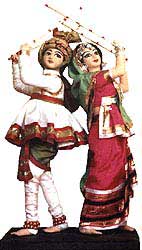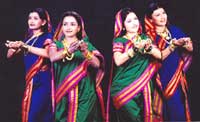Gujrat

The typical dress worn by males in rural areas consists of cotton drawers called `chorno` and a short `kediyu` or `angarakhu` covering the upper part of the body. Almost all sects of people in Gujrat, especially agriculturists still continue to put on the typical head dress, thickly folded `phento` or turban. On the other hand, Women in villages put on `chaniyo`which is a colored petticoat often embroidered with `abhala` or glass pieces, with a similarly embroidered blouse or bodice called as `choli` or `polku`.They also wear`odhani`, a colored piece of coarse cloth covering the body and the head. Elderly males of higher classes put on `dhoti` (waist cloth) and `kafani` or `peharan` (shirt).
Maharashtra

.Maharashtraian People wear very colorful dresses throughout the year, those represent different seasons of the year. Women of the society wears the Maratha `Sadi` (saree) of nine yards and a short-sleeved `Choli` (blouse) covering only about half the length of the back. The nine yards piece of cloth is generally worn by elderly ladies and is known as "Lugade" and Saree in Marathi. The Lugade is basically forty-five to forty-two inches in width, and it has two lengthwise borders `Kanth` or `Kinar`.It also has two `Breadthwise` borders, `Padar`, at the two ends, which gives a different beauty to it. The way Maratha Brahmans and other classes wear the Lugade is by tucking the hind plates into the waist at the back-centre and the decorated end (padar) thrown over the left shoulder. Maratha ladies allow it to hang form the waist down straight and round like a skirt and draw its end, which covers the bosom and back over the head.
